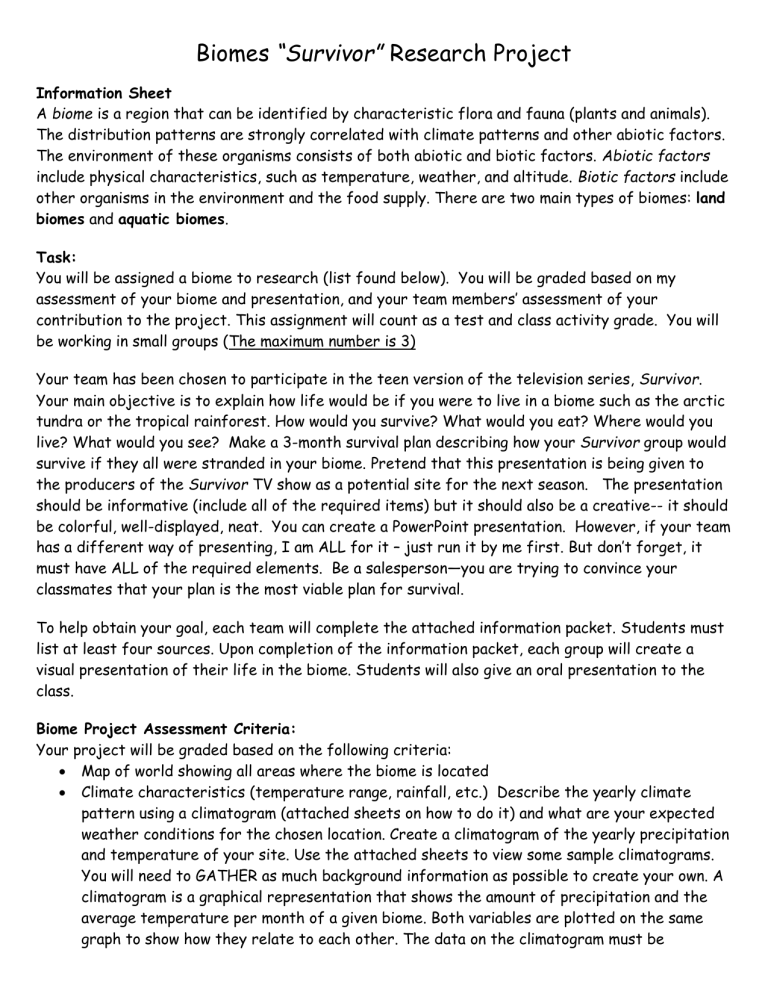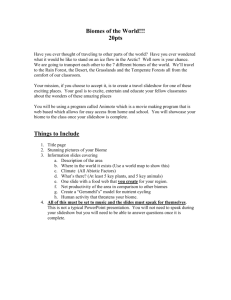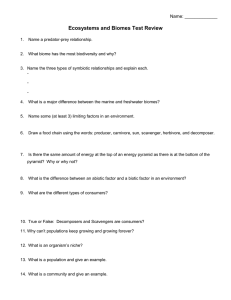Biomes Survivor Project 2018
advertisement

Biomes “Survivor” Research Project Information Sheet A biome is a region that can be identified by characteristic flora and fauna (plants and animals). The distribution patterns are strongly correlated with climate patterns and other abiotic factors. The environment of these organisms consists of both abiotic and biotic factors. Abiotic factors include physical characteristics, such as temperature, weather, and altitude. Biotic factors include other organisms in the environment and the food supply. There are two main types of biomes: land biomes and aquatic biomes. Task: You will be assigned a biome to research (list found below). You will be graded based on my assessment of your biome and presentation, and your team members’ assessment of your contribution to the project. This assignment will count as a test and class activity grade. You will be working in small groups (The maximum number is 3) Your team has been chosen to participate in the teen version of the television series, Survivor. Your main objective is to explain how life would be if you were to live in a biome such as the arctic tundra or the tropical rainforest. How would you survive? What would you eat? Where would you live? What would you see? Make a 3-month survival plan describing how your Survivor group would survive if they all were stranded in your biome. Pretend that this presentation is being given to the producers of the Survivor TV show as a potential site for the next season. The presentation should be informative (include all of the required items) but it should also be a creative-- it should be colorful, well-displayed, neat. You can create a PowerPoint presentation. However, if your team has a different way of presenting, I am ALL for it – just run it by me first. But don’t forget, it must have ALL of the required elements. Be a salesperson—you are trying to convince your classmates that your plan is the most viable plan for survival. To help obtain your goal, each team will complete the attached information packet. Students must list at least four sources. Upon completion of the information packet, each group will create a visual presentation of their life in the biome. Students will also give an oral presentation to the class. Biome Project Assessment Criteria: Your project will be graded based on the following criteria: Map of world showing all areas where the biome is located Climate characteristics (temperature range, rainfall, etc.) Describe the yearly climate pattern using a climatogram (attached sheets on how to do it) and what are your expected weather conditions for the chosen location. Create a climatogram of the yearly precipitation and temperature of your site. Use the attached sheets to view some sample climatograms. You will need to GATHER as much background information as possible to create your own. A climatogram is a graphical representation that shows the amount of precipitation and the average temperature per month of a given biome. Both variables are plotted on the same graph to show how they relate to each other. The data on the climatogram must be 1. 2. 3. 4. accurate. The months of the year should occupy the horizontal axis, and the vertical axis should be Temperature and amount of precipitation respectively. Temperature should be plotted with one color, and precipitation should be plotted in a different color. List of survival items each person will carry in their backpacks (be realistic, 15 lbs is a reasonable amount for the average person to carry) NO GUNS or OTHER POWERED PROJECTILE WEAPONS!!! Sources of "natural" renewable energy (how will the contestants stay warm or cook food???) List of indigenous (native) plants that contestants can eat – at least four. What adaptations do these plants have for your biome http://www.survivaliq.com/index.htm List of native animals can be eaten (not endangered species) – at least six. What adaptions do these animals have to have survived your biome? Plan for shelter (remember you will only have the naturally occurring resources available). Organisms that will pose a threat to you and how you will defend yourselves Construct a food web that includes contestants and other organisms in your biome. How you are going to avoid impacting (destroying) the environment while the show is there. PRESENTATION CRITERIA PowerPoint must be completed on the assigned date. You are not limited to PowerPoint; you can use other forms to supplement your presentation, video, music, etc. You are only limited by your imagination. Remember you must have addressed all the requirements to earn full credit. All slides must be readable (avoid too many flying effects, transitions, overlays, difficult to read backgrounds). If you do a video, be professional (no giggling, etc) and the audio must be clear (able to easily hear what you're saying). NO EXCUSES OF POOR WORK! All participants must PARTICIPATE; divide up the presentation... limited to 15 minutes. Presentation should look like a "sales pitch" (look it up) not a traditional report. Survivor Project Team Assessment (20 points) Evaluate your team members. Additionally, please rate your team members in terms of participation on a scale of 1-5; 5 being the highest possible score and 1 being the lowest possible score. Team Members Name Actively contributed towards group assignment Worked well with other team members Actively contributed towards the presentation (or offered ideas for the presentation) Biomes “Survivor” Research Project List of Biomes and Websites Biomes: Tundra, Tropical Rainforest, Grassland, Temperate Forest (Deciduous Forest), Taiga (Evergreen Coniferous Forest, Boreal), Desert, Savanna. Useful Websites The World’s Biomes http://www.ucmp.berkeley.edu/glossary/gloss5/biome/ Tour of Biomes http://www.cotf.edu/ete/modules/msese/earthsysflr/biomes.html Rainforest http://www.rain-tree.com http://www.snowcrest.net/geography/slides/biomes/index.html http://www.ucmp.berkeley.edu/glossary/gloss5/biome/forests.html#tropical http://www.ups.edu/biology/museum/worldbiomes.html Temperate Deciduous Forest http://www.needham.mec.edu/nps_web_docs/high_school/cur/Bio96_97/P5/ forest/Forest.html http://www.snowcrest.net/geography/slides/biomes/index.html http://www.ucmp.berkeley.edu/glossary/gloss5/biome/forests.html#temperate http://www.ups.edu/biology/museum/worldbiomes.html Taiga (Evergreen Coniferous Forest, Boreal Forest) http://www.snowcrest.net/geography/slides/biomes/index.html http://www.mobot.org/MBGnet/sets/taiga/body.htm http://www.ups.edu/biology/museum/worldbiomes.html Grassland http://www.snowcrest.net/geography/slides/biomes/index.html http://www.ucmp.berkeley.edu/glossary/gloss5/biome/grasslan.html http://www.ups.edu/biology/museum/worldbiomes.html Desert http://www.snowcrest.net/geography/slides/biomes/index.html http://www.ucmp.berkeley.edu/glossary/gloss5/biome/deserts.html http://www.ups.edu/biology/museum/worldbiomes.html Tundra http://www.snowcrest.net/geography/slides/biomes/index.html http://www.ucmp.berkeley.edu/glossary/gloss5/biome/tundra.html http://www.ups.edu/biology/museum/worldbiomes.html Wetlands http://www.jlhs.nhusd.k12.ca.us/Classes/Science/Net_Lessons/Biomes/wetlands.html http://www.epa.gov/OWOW/wetlands/contents.html Biome Map http://cissus.mobot.org/MBGnet/biome/map.htm http://www.snowcrest.net/geography/slides/biomes/index.html Biomes “Survivor” Research Project: Activity Sheet Biome: _________________________________ Names of Group Members: ___________________________________________ Remember that you need at least four sources, so be sure to write down where you found your information in question number 10. 1. List 7-10 animals (fauna) that are common in this biome. Find a variety of animals that fill different roles within this biome. Make a note of their adaptations to your assigned biome. __________________________________ __________________________________ __________________________________ __________________________________ __________________________________ __________________________________ __________________________________ __________________________________ __________________________________ __________________________________ 2. List 7-10 types of plant life (flora) common to this biome. Make a note of their adaptations to your assigned biome. __________________________________ __________________________________ __________________________________ __________________________________ __________________________________ __________________________________ __________________________________ __________________________________ __________________________________ __________________________________ 3. Describe the physical conditions in this biome (climate, temperature range, weather, and rainfall). 4. Determine where the biome is located. 5. List the biotic factors and the abiotic factors in this biome. 6. Describe what you would see, hear, smell, touch, and taste. Would you be happy living in this biome? Why or why not? Support your answer. 7. List of references where you found your materials.






